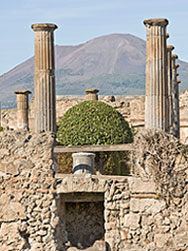Romancing the stone - Reading experts reunite Latin lovers!
Release Date 11 February 2011

With Valentine's Day fast approaching romance is in the air and this year the University of Reading has played the ultimate role of Cupid.
Dr Peter Kruschwitz and Virginia Campbell from the University's Department of Classics have used their expertise to reunite a married couple...after 2,000 years apart!
Sometimes little things result in couples going their separate ways, but sometimes it takes greater forces, like the AD 79 eruption of Mount Vesuvius. Lucius Caltilius Pamphilus and his wife, Servilia, who lived in the ancient city of Pompeii, was such a couple. The funerary inscription Lucius commissioned for his beloved wife was broken apart, the pieces scattered and buried by the destruction caused by the volcanic eruption.
Excavation of the pieces begun as early as 1813 and scholars originally recorded them as separate fragments. Virginia, whose current PhD thesis is on Pompeian tombs, and Peter, an expert in Latin inscriptions, were examining material for Pompeii when they made the exciting discovery that the pieces are actually from the same inscription. Reconstructed with skill and loving care it now reads:
‘Lucius Caltilius Pamphilus, freedman of Lucius, member of the Collinian tribe, for his wife Servilia, in a loving spirit.'
Peter Kruschwitz said: "Amazingly the inscription was fragmented in such a way that all that was missing from the first part was the name of the wife. So identifying these as parts of the same inscription literally reunited the couple.
"Dealing with fragmentary Latin inscriptions is often like playing with a giant jigsaw puzzle. You have ten pieces of what used to be a 2,000 piece game. If you manage to discover adjacent pieces and then a beautiful little vignette emerges, this is among the most fulfilling moments for anyone dealing with ancient inscriptions. This case, of course, is even more beautiful than others, because it literally reunites two human beings who once were a loving couple almost 2,000 years ago."
Lucius and Servilia are now happily side by side in the National Archaeological Museum of Naples
The Reading team's findings have been published in the most recent volume of the journal Tyche: http://www.verlag.holzhausen.at/?pid=14&lang=1&book_id=203#203
More information on current research within the University's Faculty of Arts and Humanities
Ends
Further press information from James Barr, University of Reading press office, 0118 378 7115, j.w.barr@reading.ac.uk
Notes for Editors:
The University of Reading's Department of Classics explores a range of classical subjects and issues. Its aim is to teach students to read, think and argue for themselves, and develop personal interests and skills
In the most recent Subject Review, the Department was rated 'Excellent' receiving 22 points out of a maximum of 24. The Research Assessment Exercise 2008 assessed 90% of our research output as of international excellence. This result places Reading in the top ten Classics departments outside of London, Cambridge and Oxford.
